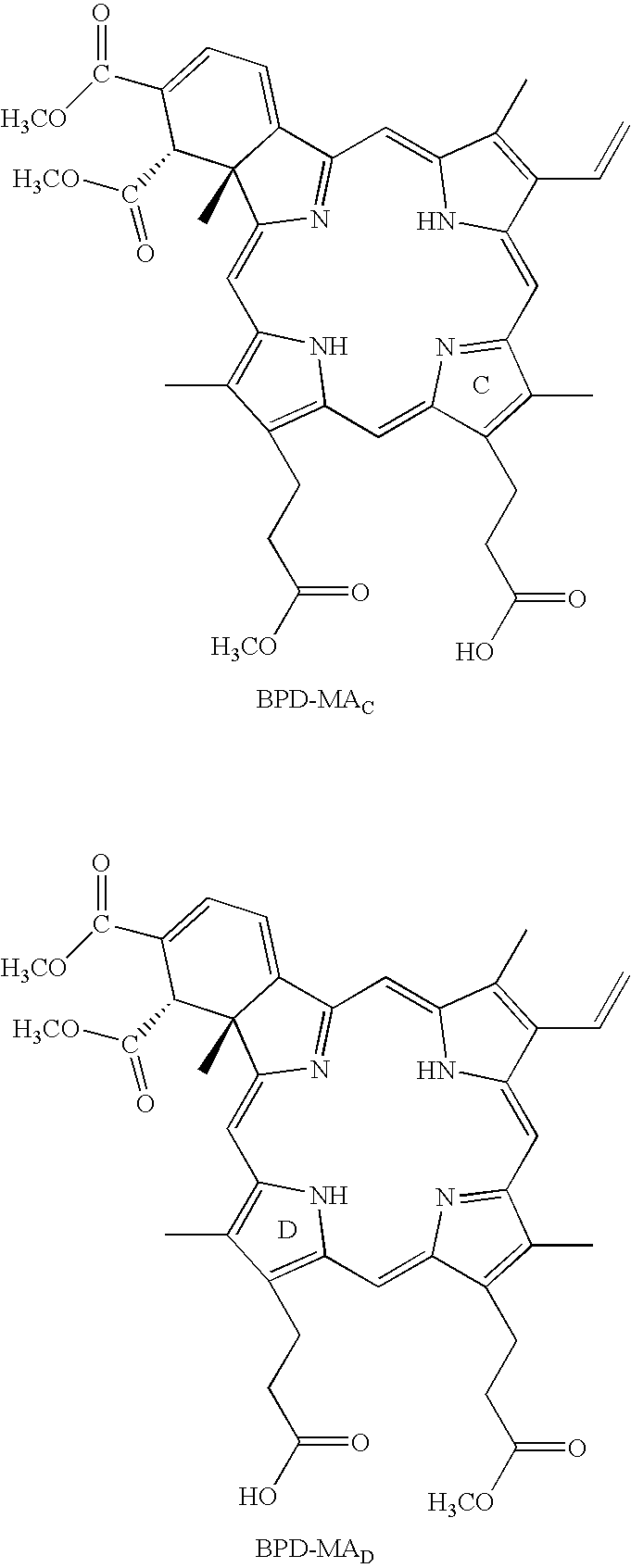Factor vii conjugates for selectively treating neovascularization disorders
a neovascularization disorder and conjugate technology, applied in the direction of biocide, drug composition, peptide/protein ingredients, etc., can solve the problems of limited patient eligibility, cnvm and retinal damage, and scarring of the affected area with consequential blindness,
- Summary
- Abstract
- Description
- Claims
- Application Information
AI Technical Summary
Benefits of technology
Problems solved by technology
Method used
Image
Examples
example 1
Synthesis of fVII-Verteporfin Conjugate
[0090]Materials and Methods
[0091]Construction of plasmid containing the mfVIIP cDNAs. The plasmid vector encoding mfVIIP was constructed by amplifying the mouse factor VII cDNA with a K341A mutation from a previously constructed plasmid vector described in U.S. Pat. No. 6,924,359. The mouse (“M”)fVIIP cDNA contains the coding sequence for mfVII, a BamHI site, ribonuclease S-peptide (wild-type or mutated) and 6 Histidines with a Hind III at the 5′-end and Not I at the 3′-end. The PCR amplified cDNAs are sequentially digested with Hind III and Not I and ligated into the Hind III and Not I digested-pcDNA3.1(+). The sequences of the inserts in the plasmids were confirmed by sequencing. A hfVIIP cDNA also has been constructed with mutated human fVII in place of mouse fVII.
[0092]Production and purification of the mfVIIP protein. The mfVIIP plasmid was transfected into Chinese Hamster Ovary (CHO) cells using the Superfect reagent (Qiagen), and the cel...
example 2
Binding of mfVIIP Protein and mfVIIPD (Conjugated to Verteporfin) to Human Tumor Cells Expressing TF
[0098]mfVIIP was conjugated to verteporfin using the procedure described above. The binding activity of the conjugate to human breast cancer cells was tested by flow cytometry
[0099]The results indicate that the binding activity, presumably to Tissue Factor on the tumor cells, was identical for the conjugated and non-conjugated molecules.
example 3
Injection of fVII-Targeted Verteporfin Followed by Laser Activation Stops Blood Vessel Leakage in Rats
[0100]Tissue factor (TF), a transmembrane receptor, forms an exceptionally strong and specific complex with its ligand fVII as the initial step of the blood coagulation pathway. TF is not normally highly expressed on vascular endothelial cells but is expressed in a significantly higher amount on endothelial cells of new vessels such as tumor vasculature, probably induced by angiogenic factors such as Vascular Endothelial Growth Factor (VEGF). A photosensitizer is attached to a targeting molecule called fVII, which selectively binds to endothelial cells of abnormal blood vessels. The model for the targeting molecule is a Camelid IgG1 antibody, which is composed of two heavy chains without associated light chains; each heavy chain contains a VH targeting domain conjugated directly to the hinge region of the Fc effector domain. The targeting molecules are composed of one or two chains,...
PUM
| Property | Measurement | Unit |
|---|---|---|
| wavelength | aaaaa | aaaaa |
| time | aaaaa | aaaaa |
| irradiance | aaaaa | aaaaa |
Abstract
Description
Claims
Application Information
 Login to View More
Login to View More - R&D
- Intellectual Property
- Life Sciences
- Materials
- Tech Scout
- Unparalleled Data Quality
- Higher Quality Content
- 60% Fewer Hallucinations
Browse by: Latest US Patents, China's latest patents, Technical Efficacy Thesaurus, Application Domain, Technology Topic, Popular Technical Reports.
© 2025 PatSnap. All rights reserved.Legal|Privacy policy|Modern Slavery Act Transparency Statement|Sitemap|About US| Contact US: help@patsnap.com


